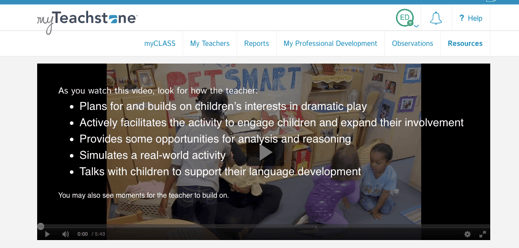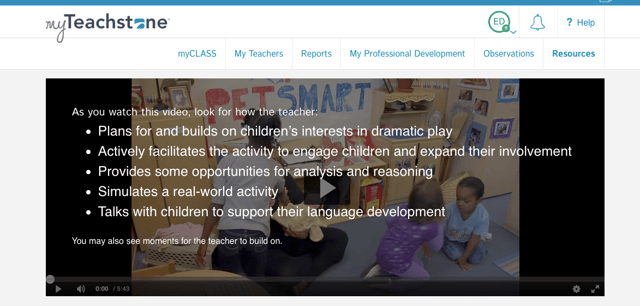
We all know that coaches and teachers have many time constraints when working to provide high quality care for young children. We designed myTeachstone to help address time issues by providing numerous and varied resources on effective interactions that allow for meaningful professional development with less face-to-face time.
Even with all of the fantastic resources, however, it can take time for coaches to create discussions that focus and promote teacher growth.
The good news is that myTeachstone resources include built-in content to make engaging teachers in effective discussion even easier. This blog series will take you through this content and provide tips for its use.
Part 1: Using "Look Fors"
We define "Look Fors" as the text you see when you hover your mouse over the video, as shown in the image below.

In this example, let's think about how teachers keep children focused during center time. Check out this myTeachstone video, Itsy Bitsy Dog (we will keep coming back to this resource for this series).
For now, ignore all of the look fors and CLASS dimensions. Just watch the video and pay attention to:
- The number of actions/activities in which the children are involved. What are all of the different topics/content areas the children are learning?
- What is your first impression of the interactions you are observing?
There are numerous answers to these two questions. The children are learning about a variety of subjects including care for pets, how stores work, the difference between small and large quantities/sizes, how to collaborate with others, etc. In terms of first impressions, you might notice how great it is that the teacher is sitting on the floor with the children or you might notice the mix of open- and closed-ended questions.
I ask you to think about these observations to remind us of the importance of learning objectives and lenses. Look fors help teachers understand these two ideas. Let’s dig deeper.
- Learning Objectives - We’ve established that there is a lot of activity in this video. The teacher and children are moving, talking, manipulating materials, and generating ideas. Even though it is only six minutes long, it can be overwhelming for teachers to know where to focus their attention or how to use this resource to enhance their own learning. Look fors are a way to provide objectives for teachers. Teachers then knows how to focus their attention, time, and energy. As a bonus, the look fors offer a way that you can know what is covered in a video when you are strapped for time!
- Lens - If you’ve been to a CLASS observation training, you know that we talk a lot about the CLASS lens. A lens is basically a way of seeing, or a way to organize what you are seeing. We all approach teaching and learning through various lenses which can sometimes distract us from an important concept that we need or want to learn. Think again about your first impression of the video. What do you think teachers’ first impressions might be? How might those impressions affect their learning about effective interactions? What happens if their impressions are different from yours?
While it is difficult to ignore first impressions, it is important to understand that they are there and how they affect learning. It is fine for teachers to have a different lens, but this can sometimes make conversation more difficult. Look fors can help create a common lens and language for you and the teachers to use when discussing effective interactions. They can also help to minimize some of the distraction that our individual lenses might create.
To close, here are a few tips for using the look fors:
- Feel free to have teachers focus on one or two of the look fors at a time. Addressing four or five behaviors at once may be too much for a teacher.
- Alternatively, for more advanced teachers, you may encourage them to focus on all of the look fors and how these behaviors affect one another.
- Watch the same resource with a different objective each time to create a rich discussion on how teachers support children’s learning.
- Encourage teachers to watch the video focused on the look fors and then watch again to see how the children respond to each of her behaviors.
- Watch the video without the look fors and then watch it again with it. Ask teachers to compare and contrast the experience of having clear learning objectives.
What about you? How have you used the look fors? In what ways do they enhance teacher learning?
In the coming days, please "look for" my next post in this series, which will focus on using the charts in myTeachstone to facilitate teachers' learning!
